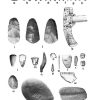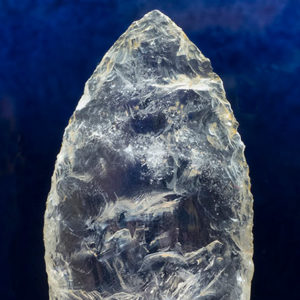calsfoundation@cals.org
Paleoindian Period
The term “Paleoindian” refers to a time 13,500 years ago (11,500 BC) at the end of the last ice age when the first traces of humans appeared in the archaeological record in North America. One of the first groups to enter the New World was the Clovis culture. They encountered many species of now extinct, large terrestrial animals and hunted them with spears tipped with stone points; these animals, dubbed “megafauna” because of their larger size when compared to modern forms, included the mastodon, mammoth, horse, tapir, ground sloth, giant bison, giant beaver, giant tortoise, American lion, short-faced bear, and saber-toothed tiger. The fossilized remains of many of these now extinct animals have been found in Arkansas. Early Paleoindian stone tools have been found with the bones of many extinct mammals in many states but not yet in Arkansas. Archaeologists divide the Paleoindian period into three subperiods: early, middle, and late. The subperiods are well represented in Arkansas on the basis of stone tools found on the surface of farm fields and on river gravel bars. The early part of the period is identified with the fluted spear point, while the middle and late portions are represented by a succession of fluted and nonfluted spear points. In Arkansas, the Paleoindian period ended about 12,850 years ago as the culture evolved into what archaeologists term the Dalton culture.
Evidence suggests that groups of hunters migrated across the Bering Land Bridge between Siberia and Alaska when the sea level was several hundred feet lower than it is today. Paleoindian campsites in central Alaska (dating to as old as approximately 11,800 radiocarbon years before present) are slightly older than sites in the lower forty-eight states. The stone tools in Alaska and Siberia are similar to those in the continental United States. DNA and analysis of the shape and nature of teeth point to central Asia as the origin of the Clovis culture. The route through the ice-free corridor in western Canada brought the first groups into what is today Montana, where the oldest known human burial associated with early Paleoindian tools was discovered in 1968 and was recently dated to about 11,050 radiocarbon years before present.
Following the major rivers and drainage divides, groups of mobile hunters migrated from one hunting ground to the next. Archaeologists have no way to estimate precisely how far or fast they traveled from one year to the next, but judging by the abundance of sites and artifacts, by the end of the Paleoindian period, the North American landscape must have been relatively well populated. Reliable radiocarbon dates, together with the geographic distribution of early stone tools, indicate the general direction of North American migration as northwest to southeast. Radiocarbon dating, the most common technique used on archaeological deposits, indicates that Paleoindian expansion across the New World took perhaps 500 to 1,500 years. The first 1,000 years of Native American occupation in Arkansas is largely unknown. An intact Paleoindian campsite has not yet been discovered in Arkansas, so information from other states must be relied on to piece together what life may have been like 10,500 to 13,500 years ago.
Paleoindians lived in an environment that was dynamically changing in climate and seasonality. Temperatures were on the average much cooler, with little seasonal variation compared to the modern era. Late ice age climatic changes caused plant communities and animal populations to change. Paleoindians arrived in Arkansas about 13,000 years ago, when hardwood forests predominated throughout the Ozarks and on top of Crowley’s Ridge. Paleoindians in Arkansas also likely would have encountered a wide variety of now extinct animal species, as well as animal species that continue to be hunted today, such as elk, white-tailed deer, and bears. The closest Paleoindian campsite to Arkansas with preserved animal remains is near Kimmswick, Missouri. There, archaeologists excavated the remains of a mastodon cow and calf and various species of small mammals, white-tailed deer, amphibians, and turtles. The remains were found in a layer of sediment that also contained Clovis points and stone debris from making and resharpening the points. Some researchers think overhunting by humans caused the mass extinction of animals in the Late Pleistocene (also known as the end of the last ice age) in North and South America. Others think changes in climate and vegetation patterns caused the animal extinction. Whatever the cause, more than thirty groups of large animals became extinct. By about 10,500 years ago, megafauna no longer roamed North America.
Perishable materials rarely survive in most Paleoindian sites, so archaeologists rely heavily on the stone artifacts from early hunting cultures to reconstruct their lifestyles. Paleoindians preferred fine-grain, silica-rich rocks called chert or flint. They practiced a core-tool technology wherein, by striking the edge of a large flint core, they produced flakes large enough to use as they were or modified into another tool, such as a spear point, scraper, graver, or perforator. The fluted point is the hallmark of the early Paleoindian period. The flute is a flake detached from the tool’s base. The scar from detaching the flute allows the point to fit snugly inside a handle or a spear shaft.
The earliest variety of fluted point is called a Clovis point after a town in eastern New Mexico near the type site (Blackwater Draw Locality No. 1, listed on the National Register of Historic Places) where Clovis points and other cultural debris were found with extinct megafauna in ice age gravel deposits in 1932. Another stone tool type specific to the early Paleoindian period is called a blade. Blades are detached from prepared cores. They could be used as they were but often were modified into end scrapers or other tools. Compared to stone tools of later cultures, Paleoindian stone tools are larger, more multifunctional, and highly portable but have shorter periods of use. In Arkansas, most known Paleoindian projectile points are fluted, but there is a succession of point types presumably made between the earlier fluted types (Clovis, Folsom, Sedgwick, Gainey) and the later Dalton point. Intermediate-age point types include Coldwater, Quad, and Pelican. Agate Basin points (circa 10,500–10,000 BC) known from Arkansas suggest high mobility and/or down-the-line transmission of information probably via exchange between Paleoindian hunters of the western Plains and people in Arkansas during the Dalton era.
Paleoindians hunted large and small mammals. Tools such as spear points, foreshafts, burnishers, billets, and shaft straighteners were made of ivory, bone, and antler. This evidence indicates that animals were hunted not only for food. Terrestrial game would have been the primary food source for Paleoindians, although there is evidence that the culture may have consumed fleshy fruits, such as grapes and berries, as well as nuts. Studies of modern hunter-gatherers indicate that the hunting of large mammals is often more efficient in terms of calories than is plant collecting. Early Paleoindians had many more species available to hunt. After the ice age extinctions occurred, the largest prey animals available to middle and late Paleoindian groups in Arkansas were modern species of bison, elk, deer, and bear.
The sparse number of artifacts recovered from most Paleoindian excavations suggests that they did not live in permanent settlements. Their groups likely consisted of a dozen to a few dozen individuals. The occurrence of exotic cherts made into tools and left at Paleoindian campsites hundreds of miles from their geologic source is evidence of long-distance movement or trade during their migration to the New World. The fact that even Clovis fluted points vary slightly from region to region indicates that the settlement of groups into small regions, where they were isolated from other groups for months to years, probably occurred fairly rapidly. The locations of fluted points found on the surface across northeast Arkansas indicate that Crowley’s Ridge was a major focal point for Paleoindians. Many of the mapped fluted point locations in northeast Arkansas correspond to plowed fields. Many more Paleoindian sites probably are in western Arkansas—the Ozarks, the Boston Mountains, and the Ouachitas—and the Coastal Plain, but because of vegetation and land use, the sites are more elusive. A quartz crystal Clovis point found near Hot Springs (Garland County) and points recently documented in northwestern Arkansas and in the Ouachitas and Boston Mountains are evidence that early Paleoindians traveled all of the major regions of Arkansas.
For additional information:
Gillam, J. Christopher. “Paleoindian Settlement in Northeastern Arkansas.” In Arkansas Archeology: Essays in Honor of Dan and Phyllis Morse, edited by R. C. Mainfort and M. D. Jeter. Fayetteville: University of Arkansas Press, 1999.
Haynes, Gary A. The Early Settlement of North America, the Clovis Era. Cambridge, UK: Cambridge University Press, 2002.
Lopinot, N. H., J. H. Ray, and M. D. Conner. 1997 Excavations at the Big Eddy Site (23CE426) in Southwest Missouri. Special Publication 2. Springfield: Southwest Missouri State Center for Archaeological Research, 1998.
Morrow, Juliet E., and Christopher Gillam. “Evidence of Paleoindians in the Highlands and Lowlands of Arkansas.” In The American Southeast at the End of the Ice Age, edited by D. Shane Miller, Ashley M. Smallwood, and Jesse W. Tune. Tuscaloosa: University of Alabama Press, 2022.
Morse, Dan F., and Phyllis A. Morse. The Archaeology of the Central Mississippi River Valley. New York: Academic Press, 1983.
Juliet E. Morrow
Arkansas Archeological Survey
 Pre-European Exploration, Prehistory through 1540
Pre-European Exploration, Prehistory through 1540 Clovis Point
Clovis Point 




I have a relative in northern Arkansas who has found what he thinks was once an ancient civilization. Deep in the woods and mountains. He described it as several caves that have artifacts all over. Arches built out of stone along with steps and walkways leading to the caves. He also described stone statues and a fossilized turtle (large) along the trail back to it. He also said he was afraid it was going to be destroyed by the rock mining. It is currently isn’t close enough to find it, but it continues to get closer.